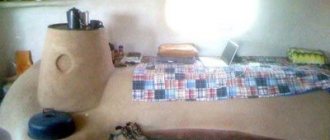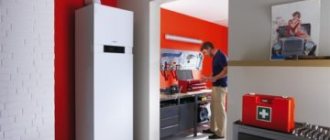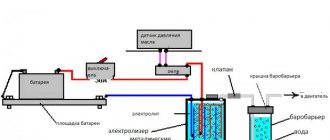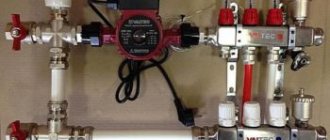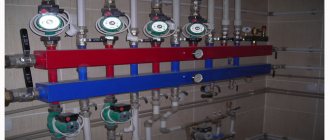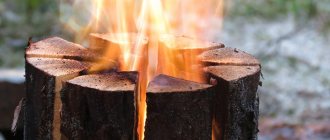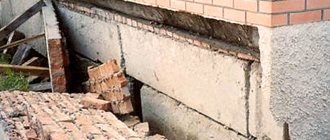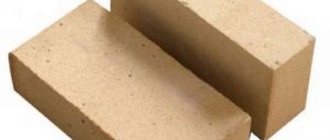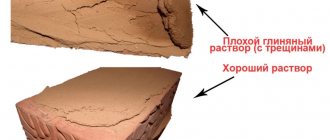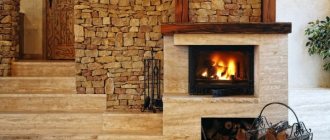Home ⋙ Solid fuel boilers ⋙
There are areas in our country where the use of wood and coal is the only method of heating. Solid fuel heating has gained particular relevance in such a situation. This heating method creates some inconveniences. But heating a house with electric devices is very expensive. A homemade pyrolysis boiler operates on wood. Another acceptable type of fuel is briquettes or any wood waste.
Making such a solid fuel structure is much cheaper than buying a ready-made device. The heat consumer will not only save money, but will also receive a heater with the required characteristics.
The manufacture of a pyrolysis boiler dictates the availability of certain tools and materials. As well as proper calculation of the invention to avoid non-compliance with safety standards.
The advantages of such equipment
Pyrolysis fuel combustion is a principle based on dry distillation. At temperatures up to 800°C and a lack of oxygen, dry solid fuel decomposes into wood coke and pyrolysis gas. The resulting gas reacts with oxygen. This activates the combustion process in a homemade pyrolysis boiler. Pyrolysis gas, in turn, reacts with carbon.
As a result, the smoke coming out of the boiler contains almost no hazardous chemicals. The solid structure of the wood also burns, producing some heat. The exothermic process produces the heat needed to warm and further dry the fuel and air space.
The main advantages include:
- Autonomous operation mode.
- Long term fuel combustion process.
- High efficiency.
- Minimum content of substances hazardous to health in the fuel material.
- It is possible to get rid of third-party waste - chipboard, rubber, fiberboard. It is worth considering that the content of third-party elements in the firebox cannot exceed 30 percent.
Making a pyrolysis boiler with your own hands means obtaining these characteristics of the device while reducing financial costs. You just need to take into account that such a boiler takes up a lot of space and only accepts dry fuel (the presence of wet firewood greatly reduces the efficiency and heat level). The pyrolysis boiler is also volatile. Connecting to an electrical source will ensure normal operation of the boiler.
Fire safety requirement
Failure to comply with fire safety rules when installing a boiler can lead to a fire, and this also jeopardizes the health and life of your family.
Basic rules to consider:
- The boiler must be installed in a specially designated place (boiler room);
- Under the base of the boiler, a platform should be paved with bricks or filled with concrete;
- The distance between the boiler and the walls should not be less than 30 cm. The walls surrounding the boiler should be covered with sheets of metal;
- It is mandatory to have a ventilation hole in the boiler room for a constant flow of fresh air.
Operating principle of the pyrolysis boiler:
Making a pyrolysis boiler with your own hands is a difficult, but completely doable task that will save a significant amount. A boiler made of high-quality metal will delight you with its warmth for many years.
A pyrolysis boiler is one of the most modern and economical types of heating units. A wide variety of solid fuels are suitable for the operation of such a boiler - from firewood and pressed pellets to peat and household waste.
DIY pyrolysis boiler
The only significant drawback of such equipment is its high cost. But if you wish, you can make the boiler yourself. To do this, you need to thoroughly understand assembly diagrams and have skills in working with welding equipment.
Do-it-yourself pyrolysis boiler (the characteristics of such a boiler are presented in the table)
Table 1. Pyrolysis, gas generator boiler. Parameters at different powers
| Options | Unit. | 15-25 kW | 20-30 kW | 40-50 kW | 80-100 kW |
| Heating capacity | kW | 15-25 | 20-30 | 40-50 | 80-100 |
| Loading chamber volume (gas generation) | m3 | 0,13 | 0,15 | 0,22 | 0,52 |
| Coolant operating pressure (no more) | MPa | 0,3 | 0,3 | 0,3 | 0,3 |
| Operating water temperature. Maximum / Minimum | 0C | 90 / 65 | 90 / 65 | 90 / 65 | 90 / 65 |
| Efficiency at fuel humidity: 20% / 40% | % | 90 / 82 | 90 / 82 | 90 / 82 | 90 / 82 |
| Nominal vacuum behind the boiler | Pa | 25 | 25 | 25 | 25 |
| Flue gas temperature | 0C | 140 | 140 | 140 | 150 |
| Electrical power consumption | W | 40 | 40 | 90 | 180 |
| Supply voltage | IN | 220 | 220 | 220 | 220 |
| Chimney diameter | mm | 194 | 200 | 200 | 219 |
| Heated area (approximately) | m2 | Up to 250 | Up to 300 | Up to 500 | Up to 1000 |
| Maximum length of firewood | m | 0,45 | 0,45 | 0,58 | 0,92 |
| Dimensions Depth * Width * Height | mm | 810 / 740 / 1130 | 810 / 740 / 1220 | 950 / 760 / 1350 | 1300 / 1030 / 1440 |
| Weight | kg | 350 | 400 | 450 | 650 |
| Fuel | – | Firewood, fuel briquettes | Firewood, fuel briquettes | Firewood, fuel briquettes | Firewood, fuel briquettes |
What will the new heater consist of?
The standard design of a pyrolysis device includes two combustion chambers. This is a prerequisite for high-quality pyrolysis.
- The loading chamber is needed specifically for the pyrolysis of fuel material. The oxygen content should be minimal. It is in this chamber that the firewood decomposes into dry residues and gases.
- The second chamber is equipped with a secondary air supply. This significantly improves the combustion process itself.
The chambers are separated from each other by an element with special briquettes.
A do-it-yourself solid fuel pyrolysis boiler will be blown with air from above. Air resistance in the firebox is combined with forced draft, which can be obtained using a smoke exhauster. Another option is a blower fan.

Rice. 1 DIY pyrolysis boiler design
Manufacturing a pyrolysis boiler will require certain financial costs. Therefore, you should evaluate not only your experience in such work, but also the availability of financial expenses. Of course, the funds will be required at least two times less than for the purchase of a ready-made solid fuel heating device.
Sizing and Power
Before you begin manufacturing a pyrolysis boiler, you should calculate the dimensions of the combustion chambers and additional compartments. The required calorific value is taken as the initial data, determined taking into account the efficiency of a homemade boiler of the order of 75–80%. At home, you can make solid fuel boilers with a power of up to 20–25 kW; more efficient units require the use of heat-resistant steel of considerable thickness, which is difficult to weld at home.
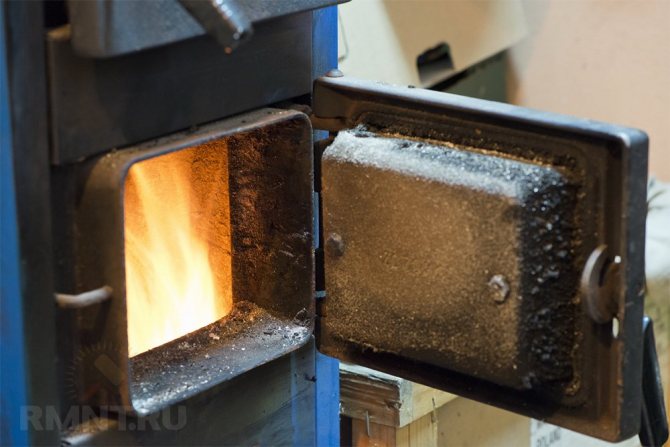
The power of the boiler and the duration of its operation are determined by the volume of the gasification chamber. Without taking into account efficiency, the calorific value of most common wood species is about 4–5 thousand kcal/kg, which approximately corresponds to 4–4.5 kWh of thermal power. These values only apply to wood with a moisture content of no more than 25%. The essence of the calculation is simple - determine the required instantaneous power and multiply it by the number of operating hours. It is worth remembering that pyrolysis boilers, even of advanced designs, have a maximum operating time of no more than a day, and self-produced units should be designed for a maximum of 12–15 hours of continuous burning.
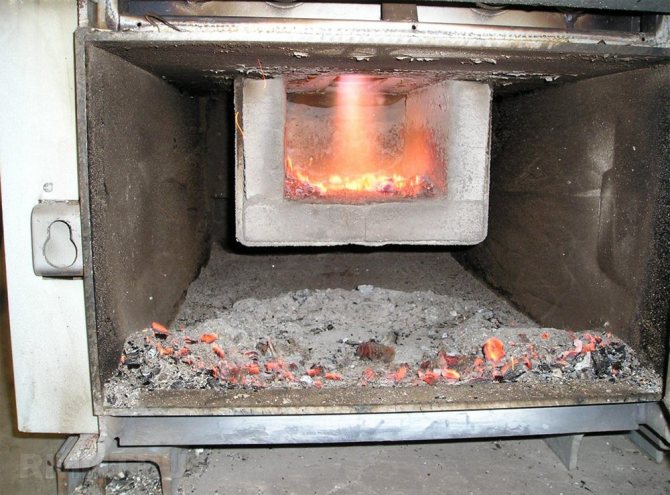
The volume of the stowage chamber is determined at the rate of 2 liters for every kilogram of firewood. You need to add about 30% to the resulting value, because in the pyrolysis boiler they use non-split lumps that cannot be laid closely. The size of the gas combustion chamber must be at least 30–40% of the volume of the gasification chamber. The most advantageous structure is considered to be a boiler structure in which two chambers are located one above the other, have the same shape, but differ in height.
Required Tools
- Electric welding preparation.
- Electric drill.
- Large grinder.
- Metal sheet 4 mm thick and approximately 7.5 sq.m. To save money, you can build the internal elements from a four-mm metal sheet, and the frame from 3 mm.
- Pipes: one with a diameter of 50 - 60 mm and a wall thickness of 3 to 8 mm, the other with a diameter of 160 mm and a wall thickness of 5 mm.
- Refractory bricks in the amount of 10-15 pieces.
- Profiled pipes 60×30 and 80×40.
- Steel strips 2 cm wide and 4 mm thick, 30 mm wide and 4 mm thick, 80 mm wide.
- 5 packs of electrodes.
- 10 cutting wheels with a diameter of 23 cm.
- 5 grinding wheels with a diameter of 12.5 cm.
- Fan.
- Temperature indicator.
In the process of completing the work, the need for some other little things may arise, but this will not particularly affect the cost.
How to assemble the structure correctly?
Before you start assembling such a complicated device as a homemade pyrolysis boiler, you need to figure out a detailed diagram. It is more prudent to use a ready-made scheme and only adjust it as necessary. There are quite a lot of such standard schemes for manufacturing a solid fuel pyrolysis boiler on the Internet.

Rice. 2 Homemade pyrolysis boilers, drawing
If the newly minted master has minimal engineering skills, the scheme can be modified. You should not change only the dimensions of the indoor unit.
During a test loading of a homemade pyrolysis boiler, it is necessary to calculate the efficiency of the device. For example, by the presence and consistency of smoke coming out of the chimney. If the smoke smells of carbon monoxide, then the efficiency of the new heating unit is too low.
Some models of do-it-yourself pyrolysis heating boilers involve the use of air, rather than water, as a coolant. Hot air is supplied through pipes and returned along the floor.
This heating scheme is convenient in a country house where the owner’s visits are periodic. This will prevent the system from freezing.
Useful tips
What if you don’t need to use a heating boiler? In this case, it is even easier to assemble a conventional pyrolysis oven with your own hands. A heat exchanger is not installed in the design of the unit.
Lifetime
Please note that the design proposed above is the most simplified option. The device will work reliably, but not for long – 5 years, no more. The walls of the boiler will burn out quickly because the pyrolysis gas burns at very high temperatures.
To extend the service life, it is necessary to line the upper firebox with fireclay bricks. It would be nice if an air chamber was built above it, through which carbon monoxide would escape into the chimney.
Correct kindling
You need to be able to melt a homemade pyrolysis boiler. For the first 10 minutes, the unit needs to work like a regular wood stove. That is, open the chimney completely, open the ash pan door more. As soon as the boiler is heated, you can close all the dampers and set the size of their gaps.
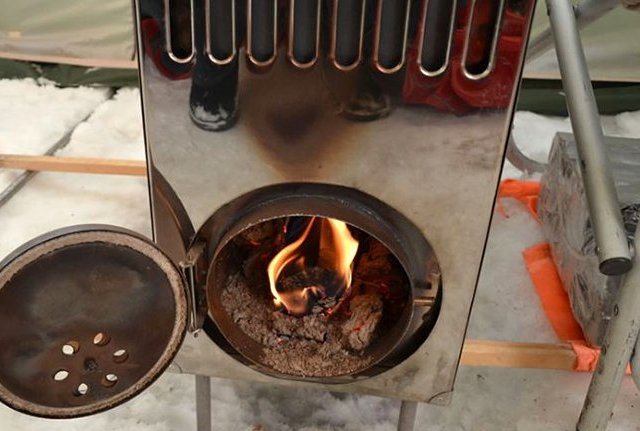
Pay attention to the smoke coming out of the chimney. If it is not present or is present in small quantities, then your heater was assembled correctly.
Instructions
- Four walls need to be cut out of steel sheets for the future solid fuel boiler. Make recesses in the front wall for the firebox and ash block.
- Cut holes for the smoke exhaust device.
- Assemble the metal walls (except for the back) by welding; the joints between the walls must be sanded.
- Then the heat exchanger is folded. Pipes are also held together by welding. Before doing this, you should put grinding wheels on the tubes themselves to eliminate the seams between them.
- The heat exchanger is installed into the boiler. Before closing the rear wall, you need to check for possible compressor leaks. If everything is in order, the wall is welded.
- The grate separates the gasification area from the fuel combustion area. The block in which the fuel will be burned is equipped with an air duct device and lined with bricks - on all sides except the front.
- The doors are attached to special compartments so that they fit snugly against the wall of the device.
- The finished heating is placed on a brick base and attached to a foil-insulated pipe. A water housing and a smoke pump are connected to the boiler. In order for a solid fuel pyrolysis machine to function automatically, it must be equipped with a temperature control system.
Gas cylinder boiler
Making a pyrolysis boiler with your own hands from a gas cylinder is quite possible. To do this, you need to cut off the top of the balloon at the rounding point. By the way, the cut off part can be used as a lid.
Its operating principle is slightly different.
Fuel material is filled through the top or side door of the cylinder and ignited until a stable fire is normalized. Then it is covered with an air duct (piston) and a tight lid with a recess for the pipe.
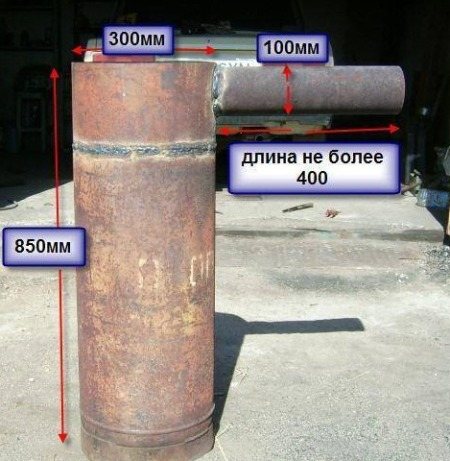
Rice. 3 Pyrolysis unit from a cylinder
The peculiar design of the piston is the result of the invention of experimental engineers. The blades rotate the flow of air coming from the pipe over the melting fuel, and an obstacle welded above the propeller prevents open fire from appearing under the pipe. Combustible gases arise from the burning fuel, flowing up the walls of the cylinder, and are burned in the upper part of the stove. Carbon monoxide escapes through the side chimney.
Dimensions of a simple 50 liter gas cylinder: height - almost 1 meter, diameter - 30 - 35 cm. These are the optimal dimensions for a medium-sized heater. The maximum dimensions of the cylinder recommended by experts for this device are: height – 120 cm, diameter – 60 cm.
How to make a wood-burning boiler with your own hands - step-by-step diagram
Step 1: Housing
We cut out the bottom from sheet metal for a pipe with a diameter of 300 mm and weld it to the end. This will be the lower part of the boiler. You can come up with comfortable legs, although if the boiler will stand on a concrete base, there is no need for them.
Step 2: Air distributor
We cut out a circle from sheet metal with our own hands that is 20 mm smaller than the diameter of the body. Drill a hole with a diameter of 20 mm in the center of the circle. On one side we weld a 60 mm pipe - the height of the pipe is slightly greater than the height of the body. The upper end is equipped with a damper to regulate the air supply. On the other side of the circle, you need to weld an impeller and metal blades no more than 50 mm wide - the blades serve to distribute air evenly.
Step 3: Doors and Covers
An ash removal door is cut out at the bottom of the boiler. Hinges and latches are welded to the door. At the top of the boiler we cut out a damper at the level where the fuel will be located at maximum load - it will serve for ignition. Fuel in this model is loaded through the top cover, in which a hole is made for the distributor pipe. The lid must be made with your own hands very accurately so that it fits tightly to the combustion chamber and does not allow smoke to pass through.
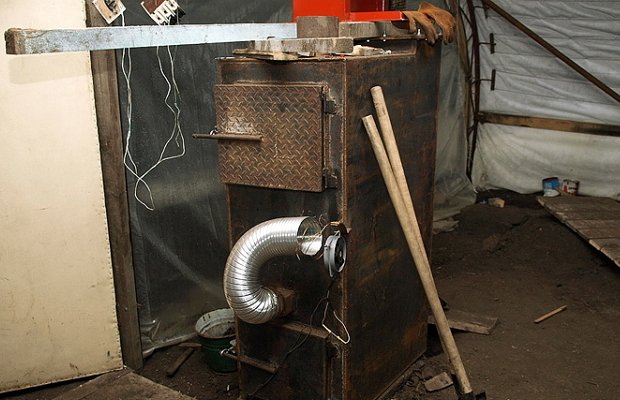
Step 4: Chimney
The chimney is welded into the upper part of the boiler from a pipe with a diameter of 100 mm. It is important that it moves at least 40–45 cm away from the boiler in a horizontal position - this way the combustion products will leave the pipe more slowly and transfer heat better to the heat exchanger.
Step 5: Heat Exchanger
The container with coolant through which the chimney will pass must be carefully insulated with insulation so that it does not release heat into the boiler room.
In such a boiler you should use only well-dried firewood, high-quality coal or peat. It should be loaded as tightly as possible, without leaving gaps. You can sprinkle a little ignition mixture on top for quick combustion. Throw a splinter through the open upper valve and, as soon as the fuel ignites, cover it so that oxygen flows in limited quantities.
- Author: Mikhail Malofeev
Rate this article:
- 5
- 4
- 3
- 2
- 1
(3 votes, average: 3.7 out of 5)
Share with your friends!
Bubafonya
This is the popular name for a pyrolysis boiler made from a barrel for heating. Such a stove is needed for burning various types of wood waste. This barrel stove boasts excellent efficiency with low material consumption. The design is more than simple.
To make a pyrolysis boiler with your own hands, you will need a barrel with a volume of 200 liters. The top plane (if there is one) must be cut off. You will also need a lid, a round piston, a pipe 10 cm in diameter up to 20 cm in length and a pipe up to 40 cm with a diameter of 10 cm for the chimney outlet.
To refuel the stove, any burning fuel with a moisture content of less than 20% is taken from the barrel. For example, wood chips, sawdust, dry rags, plain paper. The barrel is filled with fuel to 2/3 of its height and set on fire. Dry paper or a little gasoline will help the firebox ignite.
As the fuel material burns, the piston will gradually move down. The material burns slowly under the piston. Oxygen flows through the air pipe. As a result, pyrolysis gas is produced, which burns in the upper part of the barrel and generates a large amount of heat. The temperature in the barrel heating unit above the piston reaches 900 °C. Soot and gaseous substances burn to almost zero. It’s so easy to make a pyrolysis boiler yourself.
How to heat a pyrolysis boiler?
Fuel types
To fire a pyrolysis boiler you can use:
- firewood;
- peat in briquettes;
- anthracite;
- wood pellets and briquettes;
- brown coal;
- coke.
The listed fuel types differ in calorie content. The efficiency of the unit directly depends on this indicator. The use of lower calorie fuel can reduce the boiler efficiency by 30% or more.
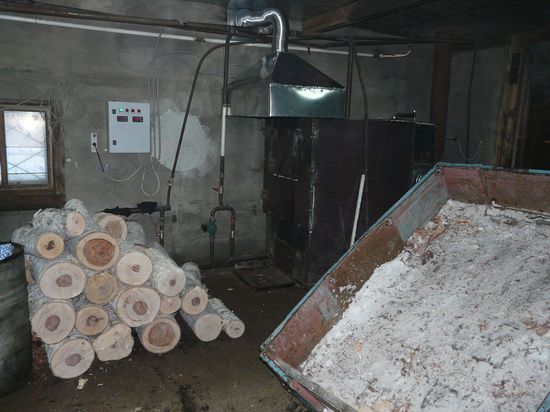
How to heat the boiler
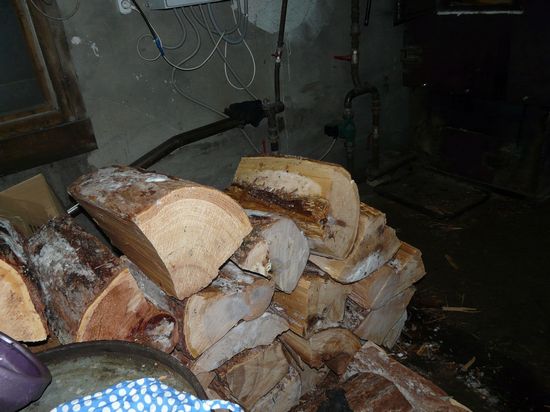
How to heat the boiler
Most often, briquettes and pellets are used to fire pyrolysis boilers. Briquettes can be made from wood, straw and peat. The ideal option is briquettes made using the pressing method. The same briquettes that are made from sawdust are recommended to be used only in combination with brown coal or firewood.
Wood or straw can also be used to make pellets. The material is pressed like briquettes.
Firewood is often used to fire pyrolysis boilers. Important! To ensure maximum equipment efficiency and reduce fuel consumption, you need to use wood with a moisture content of no more than 20%.
In general, when choosing fuel, you should take into account the characteristics of the area in which your home is located. If you live surrounded by forests, using firewood will be the most practical option. For residents of the steppe strips, as a rule, it is more profitable to heat with coal.
If any fuel is available where you live, choose the highest calorie fuel. This will ensure the highest efficiency of the equipment with minimal consumption.
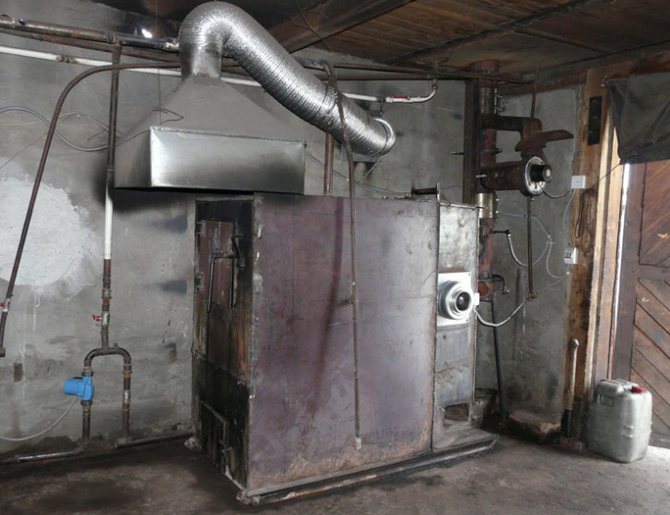
Popov's invention
Popov’s pyrolysis boiler is a specific power plant that is designed to heat water or vapor in the coolant. The basic principle of pyrolysis is that the combustion of fuel in a space limited by air is accompanied by the appearance of flammable substances. Such as carbon monoxide, methane, hydrogen, ethylene, resins.
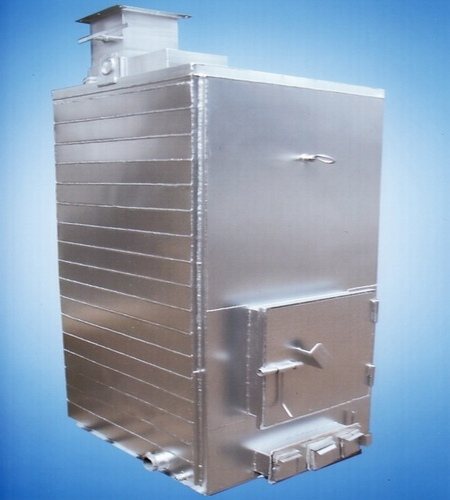
Rice. 4 Popov's boiler
This device is used in emergency conditions for system heating of a building. And also for heating baths and greenhouse buildings. The main fuels are gas, wood and coal.
The features of Popov’s homemade pyrolysis boiler include high heating efficiency, power adjustment, durability, and environmental friendliness. This design is not demanding on the moisture content of solid fuel and produces a minimum of ash during combustion.
Three regulators in the Popov boiler:
- under the door (oxygen supply to the chamber);
- on the pipe of the chimney block (installation of a damper);
- There is an internal damper in the center that prevents harmful gases from entering the room.
Popov’s pyrolysis devices are able to function without stopping throughout the entire heating season. Simply, a portion of the next fuel is supplied to the smoldering coals and the open mode is established.
